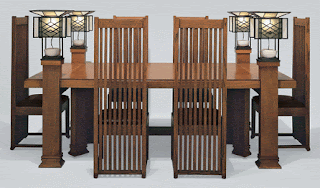At the beginning of the 20th century, World's Fairs were hubs for sharing and displaying ideas and new designs and are an example of "thinking out loud". As time went on, World’s Fairs went from being called “fair” to festival, exhibition, exposition, and expo. Their purpose was to be commemorative, commercial, collaborative, and celebratory in terms of design. The World’s Fairs were very significant because they introduced designs such as the Eiffel Tower, the automobile, and the ferris wheel. The global influence was evident as people traveled to the fairs, they brought back new ways of seeing as well as new products and ideas that influenced everyday life.
Looking back at the 19th century, design was categorized by reform that brought about the Arts & Crafts movement. Designers were in discourse about whether hand craft or machine was a better method of design, and arts & crafts believed and popularized the hand-crafted practice. William Morris was a chief practitioner of arts & crafts and believed it was a way of reviving the medieval world. Perhaps the most well known architect of all time was a designer of the arts & crafts style, Frank Lloyd Wright, who designed hand-crafted furnishings for his unique homes in this style. Wright’s holistic approach to design defined his career as an architect of the arts & crafts movement.
Wright's Dining Room Table for the Robie House
The Art Nouveau period spanned from the 1880s into the 1920s and was an aesthetic movement that emphasized fluid, curving lines reminiscent of the baroque style and used surface materials such as ceramics, glass and tile. Designers like Antonio Gaudi draw inspiration from human bones/skin and stalks/stems in their work, such as the Segrada Familia. Industrial aesthetic and exposed mechanical systems were also elements of art nouveau, like Wagner’s Postal Savings Bank, emphasizing the beauty in the “stem” rather than the “flower”. Art Deco, the counterpart to Art Nouveau, used platonic forms and circle motifs, as well as playful, polychromatic schemes such as the Miami Beach Hotels.
Segrada Familia
An Art Deco Miami Beach Hotel
Into the mid-20th century, many designers came up with their own versions of modernism. Charles Le Corbusier experimented with concrete as a form, such as the Notre Dame DuHaut, and Ludwig Mies Van der Rohe experimented with glass, like the Edith Farnsworth House. Out of this modernist work came a sub-genre of “internationalism”, meaning that no matter where in the world a building is located, they all look the same. This is mainly true with modernist skyscrapers such as Mies Van der Rohe’s Seagram Building. However modernism became known to place form over function, viewing buildings as art over habitable spaces. Philip Johnson said, “comfort is not a function of beauty”, and as a result of this thinking, many modernist buildings could not meet the functions they were intended for or had to be changed to fit human needs.
Seagram Building
The interior decorating industry was born in the early to mid 20th century as upper class housewives decorated their own homes, which became popular and allowed them to give decorating advice and services to other households. Elsie de Wolfe was a pioneer in interior decorating and was famous for revamping Victorian spaces by removing heavy ornamentation. Syrie Maughm was another early decorator who made mixing period styles popular.
room by Elsie de Wolfe
room by Syrie Maugham
Scandinavian architecture embodied the metaphors of the businesses they were designed for. For example, Som’s U.S. Air Force Academy Chapel was inspired by the flight of a plane wing, and this gesture is evident in the design. Respectively, The Scandinavian pair of Roche & Dinkeloo’s design of the College Life Insurance Building pushed the metaphor of an afterlife. Scandinavian design is a brand of modernism all its own and is still seen around the world.
U.S. Air Force Academy Chapel
College Life Insurance Building










No comments:
Post a Comment